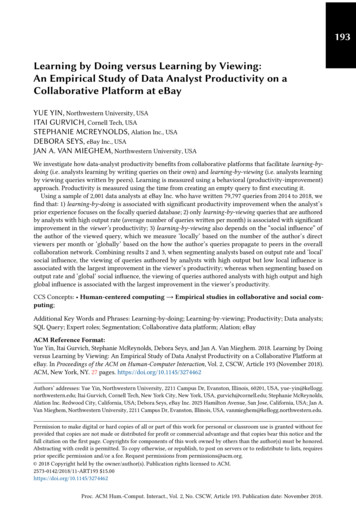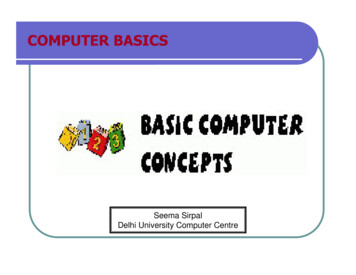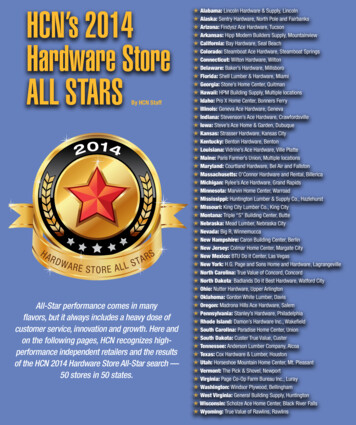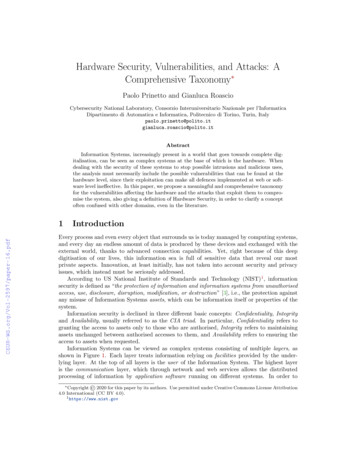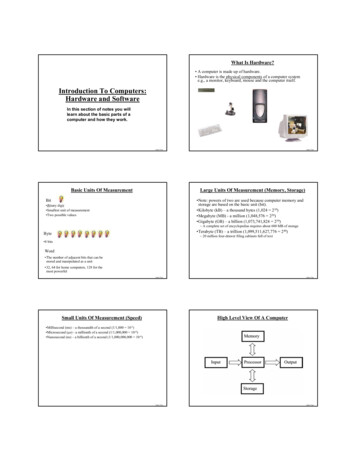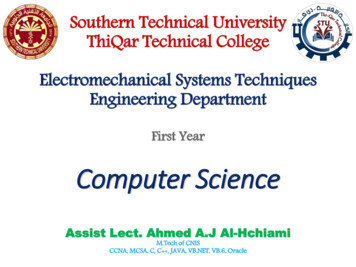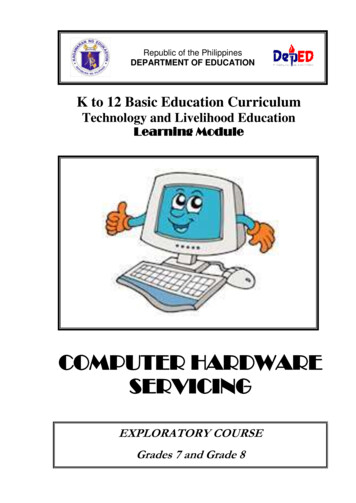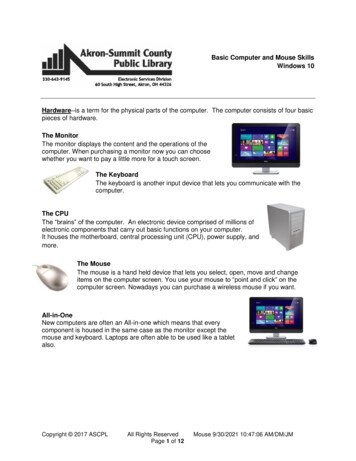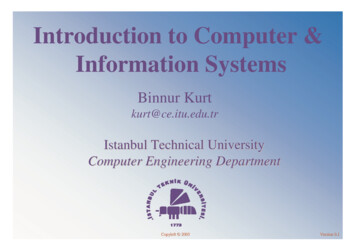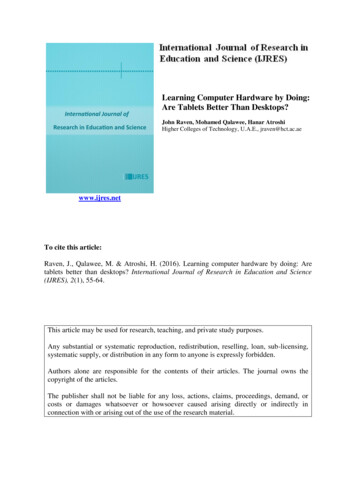
Transcription
Learning Computer Hardware by Doing:Are Tablets Better Than Desktops?John Raven, Mohamed Qalawee, Hanar AtroshiHigher Colleges of Technology, U.A.E., jraven@hct.ac.aewww.ijres.netTo cite this article:Raven, J., Qalawee, M. & Atroshi, H. (2016). Learning computer hardware by doing: Aretablets better than desktops? International Journal of Research in Education and Science(IJRES), 2(1), 55-64.This article may be used for research, teaching, and private study purposes.Any substantial or systematic reproduction, redistribution, reselling, loan, sub-licensing,systematic supply, or distribution in any form to anyone is expressly forbidden.Authors alone are responsible for the contents of their articles. The journal owns thecopyright of the articles.The publisher shall not be liable for any loss, actions, claims, proceedings, demand, orcosts or damages whatsoever or howsoever caused arising directly or indirectly inconnection with or arising out of the use of the research material.
International Journal of Research in Education and ScienceVolume 2, Issue 1, Winter 2016ISSN: 2148-9955Learning Computer Hardware by Doing: Are Tablets Better ThanDesktops?John Raven*, Mohamed Qalawee, Hanar AtroshiHigher Colleges of Technology, U.A.E.AbstractIn this world of rapidly evolving technologies, educational institutions often struggle to keep up with change.Change often requires a state of readiness at both the micro and macro levels. This paper looks at a tertiaryinstitution that undertook a significant technology change initiative by introducing tablet based components forteaching a hardware course across nine campuses in the United Arab Emirates (UAE) using a Learning ByDoing (LBD) philosophy. This paper adopts a readiness for change model (RFC) as a method of evaluating theresults from a case study that captured the readiness perceptions of both students and faculty. A surveyrevealed that, while faculty thought that introducing tablets was a good idea and that there was a high level ofRFC, they also thought that the students would learn more about hardware from desktop kits. The students’responses also indicates a high level of RFC with many describing tablets as easier to work on yet they weredivided about which technology was better for learning hardware concepts. In this context a high level ofreadiness for change, while supported by LBD, did not necessarily equate to improved learning and effectivechange.Key words: Tablets; Readiness for change; Learning by doing; Teaching hardwareIntroductionOne of the most significant changes in computer technologies in recent years has been the shift away fromdesktop computers towards more mobile devices and in particular, the emergence of the tablet. Managing thischange requires a high level of readiness by both individuals and organizations. Tablet sales have skyrocketedsince Apple introduced the iPad in 2010 and now outsell traditional desktops and notebook sales combined andare expected to continue to do so (see table one). Recently M2 Presswire observed that sales of desktop PC’shave declined by nearly 20% evidently because, “consumers dedicate more of their budget to other deviceslike tablets” (2013).Table 1. Worldwide Device Shipments by Segment (Thousands of Units) Atwal (2014)Device Type201320142015Traditional PCs (Desk-Based and Notebook)296,131276,457261,005Ultramobile Premium21,51737,60864,373PC Market ,904Mobile Phones1,806,9641,859,9461,928,169Other 09,5582,535,060There are signs that the interest in tablets is maturing, which has led some to argue that they are purely a nicheconsumer device (Reed, 2010). Regardless, tablets are now commonplace and are here to stay. This reflectschanges in the way we commonly access information and will continue to change the way we access it with newtablet applications coming out every day. Atwal observes that, “the device market continues to evolve, with therelationship between traditional PCs, different form factor ultramobiles (clamshells, hybrids and tablets) andmobile phones becoming increasingly complex"(2014). The trend towards smaller, more mobile devices withprimarily touch screen interfaces has implications for many sectors of the community including educationalenvironments that specialize in teaching information technologies and systems.*Corresponding Author: John Raven, jraven@hct.ac.ae
56Raven, Qalawee & AtroshiEducation is a complex business with a long history of practitioners looking for the latest gadget to improve orchange learning. As with any new technology Murray and Olcese (2011) point out that there are the enthusiasts,or early adopters, that insist tablet technology will transform learning and then there are the skeptics whobelieve that it will makes no difference.Technological change happens in Education, but, as Marcovitzobserves, it is difficult and takes time. He adds that, “we must focus on the innovation, the people, and theculture of the school” (2006. P.13). The introduction of tablets into learning environments, therefore, is nodifferent from a long list of other technologies introduced over the years; it must be done right.Many studies exist that examine the use of tablets and their applications in various learning environments(Palmo Thinley et al, 2014). Despite the availability of hundreds of thousands of apps, Murray and Olcese intheir review of educational software declared, "we do not think the iPad will ignite a revolution in schools"(2011, p. 48). Yet, there are many studies of instances in which tablets can aid learning indicating an evolutionrather than a revolution in technology. In the UAE, for instance, Hayhoe demonstrated how well an iPad couldbe adapted for special needs students using its intuitive navigation and multimedia capabilities. Bennett hasdemonstrated how just a few tablets in a classroom can have a positive impact on individualized learning withthe key being, "innovative instructional design"(2011-12, p.23). A tablet PC, as van Oostveen et al point out,“cannot by itself, instigate redefinition of learning tasks to allow for meaningful learning to occur” (2011, p 78).The learning environment needs to suit the affordances of the tablet.This study takes a different perspective by physically deconstructing the tablets and using their components inan activity centered LBD environment for teaching hardware courses as well as desktop computer componentsused previously. The focus is on the hardware rather than the software. Moving from easily available stockcomponents to tiny, bespoke pieces is a large change. Are the students and the organization ready for thischange? Do they learn more or less about hardware using tablets? Is it an effective change, an improvement onthe old way of doing things?Readiness for ChangeAll organizations, including educational institutions, need to keep up to date and change to be relevant in themarketplace. As Edmunds puts it, “They need to react quickly to the global revolution while at a local andnational level have to keep up with new technology and competition if they want to stay ahead of the game”(2011, p. 349). With the emergence of tablets globally as personal computing devices, educational institutionstherefore, need to examine how they can best incorporate these new devices into learning environments.However, changes such as these naturally create tension or resistance to change within the organization, whichcan be addressed by examining models of readiness for change.Stemming originally from Lewin’s (1948) work on unfreezing and freezing behaviors, organizational Readinessfor Change (RFC) has been described as a process by Kotter (1995). This process is influenced by key factorswhich, according to Lehman, Greener and Simpson (2002), include aspects of the individuals involved in thechange including their motivation, skills and knowledge as well as aspects of the organization, such as theavailability of suitable resources and the organizational climate. Armenakis and Harris (2002) grouped RFCfactors into five main categories namely: Discrepancy; Principal Support; Efficacy; Appropriateness; andValence. Recently, in a study of a Dubai e-government initiative, we suggested that these categories can beviewed from a variety of depths from micro to macro depending upon whether the lens is focused on theindividual or on wider organizational issues (Samara and Raven, 2014).In this study we will use this micro-macro RFC model to examines an instance of technological change in ahardware class. Of interest is how efforts to meet current trends away from desktop PC’s towards more mobiledevices in an educational setting are influenced by both individual and organizational RFC factors. The contextof the study is at a vocational college in the United Arab Emirates (UAE).Learning by Doing at HCTThe Higher Colleges of Technology (HCT) is the largest provider of tertiary level education in the UAE with 17campuses around the country that offer applied bachelor degree programs to Emirati students in a variety ofdisciplines including Computer Information Science (CIS). As I have discussed previously, the collegesemphasize the applied aspects of learning with a view towards building vocational skills and the emiratization ofthe workforce in the UAE (Raven, 2011).
International Journal of Research in Education and Science (IJRES)57Recently HCT adopted the Learning by Doing slogan (LBD) to highlight its support for active learningstrategies in all courses and programs of study. Support for activity centered learning is not new, deriving fromConfucian ideals and underpinned by constructivist philosophies (Gergen, 1995, von Glaserfeld, 1995).Constructivist approaches to education encourage student- centered, active learning environments that Newman,Griffin, & Cole (1989) once described as a “construction zone”. LBD approaches help avoid the “catatonia” thatcan occur in passive learning teacher centered environments (Felder and Brent, 2003, p.282). HCT similarlysupports active learning strategies stating that LBD, “is an approach to education where students acquireessential knowledge and skills through active, self-reflective engagement with the world inside the classroomand beyond” (2015). Obviously some courses are better suited for LBD than others depending on the subjectmatter with IT classes typically being good candidates due to their emphasis on building practical skills andknowledge.As Sakar and Craig point out, a common problem with computer hardware courses is that they can be, "ratherdry and theoretical" (2006, p. 150), which can demotivate students. These authors specify that a hands-on, LBDapproach should be used to enhance learning in this particular subject. Since their inception approximately 20years ago, computer hardware courses at HCT have always been lab based, with a requirement that studentsbuild computers from components before going on to configure and network them. The stated course learningoutcomes (listed below) of the current hardware course, listed as CIS-1103: Hardware and Networking, reflectthis practical approach: CLO 1- Recognize various types of computer systems: identify and explain the function of theircomponents. CLO 2- Construct a computer from physical components and recognize different hardware componentsand specifications. CLO 3- Define the role of operating systems and demonstrate the ability to install and apply therequired configuration of an operating system. CLO 4- Explain standard network models and demonstrate the ability to construct and operate a peer topeer network.In the first semester of the 2014-15 academic year it was decided by the system wide CIS academic team thattablet kits should be introduced in CIS-1103, being offered at nine separate campuses, to augment the traditionaldesktop kits that had been used for many years to meet the second learning outcome. All in one kits weresourced from China. Figure one illustrates the components and an assembled working tablet.Figure 1. Examples of the tablet PC kitsUnlike desktop PC components that can be used for many semesters, the tablet kits required soldering and canonly be used once. To recoup costs, it was planned that the working tablet PCs would be sold off at the end ofeach semester. To help students, step by step instructions and videos for assembling the tablets were developedand provided to students, as seen on the laptop screen in figure two next to a student soldering wires thatconnected the individual components together.
58Raven, Qalawee & AtroshiFigure 2. A student soldering the tablet components togetherNaturally there were concerns about how well teachers and students adapted to the tablets and learned fromthem with some enthusiasts and some skeptics - as expected. As part of the new initiative faculty at one of thelargest campuses, located in Sharjah, decided to carry out research into the effectiveness of these changes beingmade to the way the course was being taught.MethodTwo different surveys were given out towards the end of the first semester during the 2014-15 academic year tostudents and faculty involved in the hardware course. During this semester both traditional desktop PC andtablets PC kits were used as a transition method so that the two platforms could be directly compared. Onesurvey was designed for faculty teaching the course across different campuses and the other to five sections ofstudents taking the course at the two Sharjah campuses. The survey used a mixed method approach containingquantifiable fixed choice questions and qualitative open ended questions. The questions are revealed in theresults in the next section. Because the faculty were spread around the UAE and also because of the need foranonymity, the faculty completed the survey electronically (using surveymonkey.com) while the students filledin written surveys, which was easier as they were all in one area. A total of 11 faculty teaching the course and82 students taking the course completed surveys.ResultsThe results are divided into two sections. First, the faculty responses or perceptions of change, in chart formwith a representative selection of qualitative data followed by the student responses.Faculty Perceptions of ChangeThe first three questions in the faculty survey were designed to assess readiness for change on both the micro, orindividual level, and the organizational or macro level. Two other direct questions assessed whether the facultythought that the change was effective for learning, that is, an improvement.
International Journal of Research in Education and Science (IJRES)59Figure 3. Was it a good idea to switch from building desktops to tablets in this course?This result shows how supportive the faculty were to the idea of incorporating tablets into the course. They werestrongly in favor, which reflects their openness to change.Figure 4. Was the college ready to change from desktop to tablet kits?This finding indicates that the faculty believed that sufficient resources were provided by the college forchanging to the tablet PCs. This indicates a high level of organizational readiness for change at the macro ororganizational level.Figure 5. Were faculty provided with enough training and skills for the tablet kits?Individually the large majority of the faculty responded that they were sufficiently skilled to teach the courseusing tablet PC kits indicating a high level of individual or micro level readiness for change. This result alsosupports a high level of organizational readiness for change through the provision of sufficient professionaldevelopment.
60Raven, Qalawee & AtroshiFigure 6. Do you think students learn more or less about basic hardware concepts using tablet kits in comparisonto desktop kits?The large majority of the faculty, while ready for change, thought the students learned less about basic hardwareconcepts using the tablets. This is surprising given their support for the idea and individual readiness for change.Figure 7. Which do you prefer for teaching hardware concepts?Adding to the result above, many of the faculty preferred using traditional desktop PCs for teaching basicconcepts, although there was also some support for using tablets as well as for both. The qualitative results weredesigned to give more information regarding these preferences.What are the Benefits or Advantages of Changing to Tablet Technology?The faculty comments listed below endorsed the need to keep up to date with new technologies: We should adopt using modern technology.New experience for the students. The experience was beneficial as the students are more attached totablet devicesThe students found it very interesting and challenging. It is a product in the market not like desktops asthey are losing the market to All in One computers.Its more up to date current technology. Students relate more to this than desktops.Students were excited and enjoyed learning wiring & soldering skills in addition to knowing howcomponents are assembled in TabletsThe last comment reflected a new practical skill introduced with the tablet kits: soldering wires.Describe Any Issues or Disadvantages Associated with Changing to Tablet KitsThe faculty comments listed below indicate both practical and learning concerns:
International Journal of Research in Education and Science (IJRES) 61The number of the labs they practice is much less. No spare components if any are faulty. Not everyaspect of the course outlines can be covered here.Not an option, students need to touch the basics before the in-built componentsWe cannot only teach tablet kits assembly. Prior knowledge of desktop kits is required, becauseconcepts can be more clearly explained here.Tablets can easily be damaged through wrong wiring or soldering.If better quality tablet kits were ordered, the number of working assembled tablets can be increased.Half of the comments point out a concern with the fragility of the tablet kits used and half a concern that thetablet kits did not fully address the basic hardware knowledge required to meet the course learning outcomes.Overall, the faculty feedback, while indicating a high level of readiness for changing from one platform toanother in this course, also expressed doubt that the changes were effective in terms of improving learningoutcomes.Student Perceptions of ChangeThe students were the recipients rather than the instigators of the change process who worked on both desktopand tablet kits during the semester. We therefore took an indirect approach to assessing the change process andincluded survey questions that asked them to compare the tablet kits to the desktop kits. This addressed howwell the course coped with the change from the students’ point of view we believed.Figure 8. Which was easier to work on – tablets or PC kits?This result indicates that, in general, the students had no difficulty in changing from building desktop PC kits totablet kits. Indeed, nearly half, found the tablets easier to work on. This reflects that the course materials andinstructions adapted well to the change. This supports the view of a high level of readiness for change for thisparticular course at both the micro and macro level.Figure 9. Is it better to learn hardware concepts from desktop PC's or tablet kits?The mixed response to this question by the students indicates that they had no clear preference, or perception,about the best platform to use for learning hardware concepts which contrasts with the faculty perceptions. Thequalitative questions were designed to find out more about their choices. Below is a representative selection ofstudent comments regarding the choices they made regarding a preferred platform.
62Raven, Qalawee & AtroshiStudent Written Responses: Why Did You Choose?Desktops Because we can learn more on the desktops. Because desktops have a lots of parts to know and learn what to do. Because all hardware parts are bigger and easy to see. Tablets are tiny and hard to fix. Desktops are much easier to deal with. Because we see everything about the computer and know what it is. Because it’s more difficult than tablets. We use desktops more than tablets.Tablets Because it has welding. It is easier. They are simple. Not too many components. Because it’s more handy and you are able to see everything clearly. Less complicated. Easier to use and smaller than the PC. Because it is easy to carry it. Because the parts of a tablet is easy to learn. Its more simple in our level and it’s good for starting learning then we can learn more from thedesktops in the next level.The same Both are important to learn as an IT student Because we know it anyway if it is on tablets or desktops. Because I can identify every component in both of them. Because both of them give us the opportunity to touch the hardware. Because we know about any pieces on both and how work together and what the difference in betweendesktop PC and tablet. To know new information. Because they are different. To take more knowledge Actually we will never make tablets and desktops in our lives so it is unnecessary to do it here.A wide variety of reasons were given by the students for their choices with no clear consensus or preference.Many of the comments about a specific platform concerned practical issues such as the size and number of thecomponents and how they went together rather than how much they learned. Students who chose both the sametended to comment more on learning issues with the majority voicing the importance of both platforms. In termsof assessing readiness for change, the results indicate that the students readily adapted to the tablet kits eventhough they may not have been aware of broader learning issues that faculty raised.ConclusionThe results indicate that the hardware course was ready for change at both the micro and macro levels eventhough the use of tablet hardware kits were less effective than desktop kits for meeting the learning outcomes ofthe course from the faculty point of view. Even though there was willingness to change, the evidence indicatessupport for retaining both desktop and tablet platforms as LBD activities for various reasons includingrecognition of the need to keep the course fresh using modern technology while retaining the learning benefitsof using traditional desktop hardware. The results from the students indicate their willingness to change also, asmany commented that tablets were easier to work on than PC’s but were evenly divided about which technologywas better for learning hardware concepts. These findings echo Lehman et al's observation that, "Althoughorganizations need to be able to adapt to changing demands and environments, change for change sake does notnecessarily lead to more effective outcomes"(2002, p. 198 ). In this course, there is a need and a readiness tokeep up with rapid changes in computer hardware yet retain the core concepts of computer systems at the sametime using traditional components.Readiness for change, while useful for understanding the factors that contributed to the acceptance of newtechnologies in this setting, was not sufficient in itself for supporting effective change. This suggests the need to
International Journal of Research in Education and Science (IJRES)63view the outcomes, as well as the inputs and processes measured by the micro-macro RFC model, whenassessing change in contexts such as this. A possible link between LBD and RFC was illustrated in this study.We believe that the high level of RFC demonstrated at both the micro and macro levels in this context was due,in part, to the use of a student-centered LBD approach. LBD incorporates active rather than passive learning,which by its very nature is dynamic and more ready to embrace the change process. This highlights that changeand learning are intrinsically related. We suggest that further research could be conducted into the relationshipbetween the LBD and RFC constructs.RecommendationsIt is recommended that a readiness for change perspective be taken into account for all courses that areundergoing significant change as well as traditional outcomes evaluation. For the CIS-1103: Hardware andNetworking course it is recommended that PC kits be retained as well as the tablet kits as it has beendemonstrated that both add value to student learning for different reasons. It is also recommended that thiscourse continue using LBD activities and continue to be ready to change to include new hardware as it becomesavailable in the market and that the quality of the hardware be optimized as much as possible.ReferencesArmenakis, A.A., Harris, S.G. (2002), Crafting a change message to create transformational readiness, Journalof organizational change management, Vol.15 (2), pp.169 -183Atwal, R. (2014) Gartner Says Sales of Tablets Will Represent Less Than 10 Percent of All Devices in 2014.Retrieved from http://www.gartner.com/newsroom/id/2875017Bennett, K.R. (2011-12) Less than a class set: Learning and leading with Technology. pp. 22-25.Bura, K. (2014) Worldwide Tablet Shipments To Reach 315 Million In 2014, Will Account For 75% Of MobilePC Market By 2017. Retrieved from rket-2017-1553914Edmunds, J. (2011) Managing Successful Change. Industrial and Commercial Training. Vol 43(6). pp. 349-353Felder, R.M. and Brent, R. (2003) Learning By Doing, Chemical Engineering Education, 37(4), 282–283.Gergen, K. J. (1995). Social Construction and the education process. In L. P. Steffe & J. Gale (Eds.),Constructivism in Education (pp. 17-39). New Jersey: Lawrence Erlbaum Associates.Hayhoe, S. (2012) Using an iPad as an assistive device to improve technical literacy:Trial usage with anEmirati student. E-Learning in Action, HCT Educational Technology Series 1, HCT Press, pp. 197-205,ISBN 978-9948-16-864-5HCT (2015) Learning by Doing. Retrieved from http://www.hct.ac.ae/learning-by-doing/Kotter (1995) Leading Change: why transformation efforts fail. Harvard Business Review, March- April. pp.59-67.Lehman, W.E.K., Greener, J.M., Simpson, D.D. (2002) Assessing Organizational Readiness for Change. Journalof Substance Abuse Treatment. Vol 22. pp. 197-209.Lewin, K. (1948) Action research and minority problems. In G. W. Lewin (Ed.), Resolving social conflict (pp.201-216). New York: Harper & Row. (Reprinted from Journal of Social Issues, 2, 34-46, 1946)M2 Presswire (2013) EMEA PC Shipments Contracted 20.2% in 1Q13 as Consumers Continue to DivertSpending to Tablets While Commercial Spending Remains Constrained, says IDC. Retrieved January2015 from tmMarcovitz, D.M. (2006) Changing Schools with Technology: What Every School Should Know AboutInnovation. Technology and Education: Issues in Administration, Policy, and Applications in K12Schools. Retrieved http://dx.doi.org/10.1016/S1479-3660(05)08001-7 pp. 3-15.Murray, O.T. and Olcese, N.R. (2011) Teaching and Learning with I-Pads: ready or not? Tech trends. 55(6),November/ December, pp. 42-48.Newman, D., Griffin, P., & Cole, M. (1989). The Construction Zone: Working for cognitive change in school.N.Y.: Cambridge University Press.Raven, J.(2011) Emiratizing the education sector in the UAE: contextualization and challenges, Education,Business and Society: Contemporary Middle Eastern Issues, Vol. 4 Iss: 2, pp.134 – 14. Retrieved icleid 1926573&ini aobReed, B. (2010) Tablets won't kill the PC anytime soon, says analyst: Gartner: Despite hype, tablets will 98B4368PQ/20?accountid 1215
64Raven, Qalawee & AtroshiSakar, N.I. and Craig, T.M. (2006) Teaching computer hardware and organisation using PIC based projects.International Journal of Electrical Engineering Education. 43(2) pp.150-163Samara, K. and Raven, J. (2014) A Readiness For Change Model For Dubai e-Government Initiative.Proceedings of the 12th International Conference e-Society conference 2014 pp. 19-26. ISBN: 978-9898704-03-0Palmo Thinley, P., Geva, S., Reye, J. (2014) Tablets (iPad) for M-Learning in the Context of SocialConstructivism to Institute an Effective Learning Environment. International Journal of InteractiveMobile Technologies. Vol 8(1). ISSN: 1865-7923van Oostveen, R., Muirhead, W., Goodman, W.M. (2011) Tablet PCs and reconceptualizing learning withtechnology: a case study in higher education. Interactive Technology and Smart Education. Vol. 8 No. 2,pp. 78-93von Glaserfeld, E. (1995b). A constructivist approach to teaching. In L. P. Steffe & J. Gale (Eds.),Constructivism in Education (pp. 3-15). New Jersey: Lawrence Erlbaum Associates.
This study takes a different perspective by physically deconstructing the tablets and using their components in an activity centered LBD environment for teaching hardware courses as well as desktop computer components used previously. The focus is on the hardware rather than the software. Moving from easily available stock components to tiny, be.
